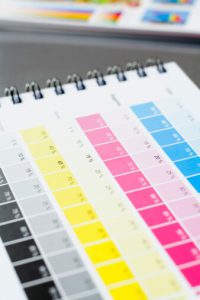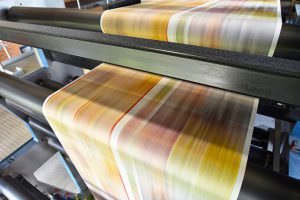Glossary of Terms
Absorption
In paper, the property which causes it to take up liquids or vapors in contact with it. In optics, the partial suppression of light through a transparent or translucent material.
Against the Grain
Folding or feeding paper at right angles to the grain direction of the paper.
Archival Quality
Neutral PH for permanence.
Baggy Roll
A roll that gives non-uniform drawing across the web. There are slack and tight sections across the width of the sheet.
Biological Diversity
The variability among living organisms from all sources including, inter alia, terrestrial, marine and other aquatic ecosystems and the ecological complexes of which they are a part; this includes diversity within species, between species and of ecosystems.
Blisters
Blisters are small, bubble-like formations which appear on both sides of the web in exactly the same area, primarily in areas of heavy ink coverage. Excessive moisture cannot escape because the ink coverage traps it.
Brightness
Refers to percent of light reflected back from a sheet of paper
Brightness Scale
The amount of light reflected by the paper expressed as a percentage
Bulk
The degree of thickness of paper. In book printing, the number of pages per inch for a given basis weight.
Burst C.D.
Short irregular ruptures of the web in the cross-machine direction. This defect occurs at regular intervals but usually does not extend to the edge of the web.
Bust M.D.
A complete rupture of the web in the machine direction. Defect is sometimes visible at the edge of the roll appearing as a stickout, but many times is hidden inside the roll and is not discovered until the roll is unwound.
Calender Cuts
Calender cuts have a glazed edge and are straight, sharp cuts running for a relatively short distance at an angle to the direction of the web travel.
Chain of Custody
The channel through which products are distributed from their origin in the forest to their end-use.
Coating
In platemaking, the light sensitive polymer or mixture applied to a metal plate. In printing, an emulsion, varnish or lacquer applied over a printed surface to protect it. On paper coating ranges from dull to very glossy. This creates paper with greater smoothness, higher opacity and better ink holdout than uncoated papers
Coating Streak/Lumps
A coating streak will show up as an area of light coat-weight or as a broad indentation in the coating surface. The length may vary from a few feet to several hundred feet in the machine direction.
Color Balance
The correct combination of black, cyan, magenta and yellow to (1) reproduce a photograph without color cast, (2) produce a neutral gray, or (3) reproduce the colors in the original scene or object.
Color Correction
Any method such as masking, dot etching, re-etching and scanning, used to improve color rendition.
Continuous Tone
A photographic image contains gradient tones from black to white.
Copy
Any furnished material (typewritten manuscript, pictures, artwork, etc) to be used in the production of printing.
Corrugations
Diagonal ridges and furrows running in the machine direction and of a relatively constant width which occur around the circumference of the roll.
Dimensional Stability
Ability to maintain size; resistance of paper or film to dimensional change with change in moisture content or relative humidity.
Dot Gain
In printing, a defect in which dots print larger than they should, causing darker tones or stronger colors.
Dots per Inch (DPI)
A measure of the resolution of a screen image or printed page. Spots per inch (spi) is a more appropriate term.
Drawdown
In inkmaking, a term used to describe ink chemist’s method of roughly determining color shade. A small glob of ink is placed on paper and drawn down with the edge of a putty knife spatula to get a thin film of ink.
Ecosystem
A community of all plants and animals and their physical environment, functioning together as an interdependent unit.
ENAMEL
A term applied to a coated paper or to a coating material on a paper. The term is usually used referring to glossy paper
FIBER CUT
A short, straight cut located on the edge of the web, caused by a fiber imbedded in the web of the paper.
Forest integrity
The composition, dynamics, functions and structural attributes of a natural forest.
Forest management unit (FMU)
a clearly defined forest area with mapped boundaries, managed by a single managerial body to a set of explicit objectives which are expressed in a self-contained multi-year management plan.
Forest stewardship
forest management which, in conformity with the FSC Principles and Criteria for Forest Stewardship, is environmentally responsible, socially beneficial, and economically viable.
HAIR CUT
A hair cut is a short, smooth curved cut having no definite length or direction, which is caused by hair, or some synthetic fiber getting into the paper.
HALFTONE
The reproduction of continuous tone images, through a screening process, which converts the image into dots of various sizes and equal spacing between centers (AM screening), or dots of equal size with variable spacing between them (FM screening).
HALFTONE DOT
Pattern of different sized dots to simulate continuous tone images
High Conservation Value Forests
High Conservation Value Forests are those that possess one or more of the following attributes: a) forest areas containing globally, regionally or nationally significant : concentrations of biodiversity values (e.g. endemism, endangered species, refugia); and/or large landscape level forests, contained within, or containing the management unit, where viable populations of most if not all naturally occurring species exist in natural patterns of distribution and abundance b) forest areas that are in or contain rare, threatened or endangered ecosystems c) forest areas that provide basic services of nature in critical situations (e.g. watershed protection, erosion control) d) forest areas fundamental to meeting basic needs of local communities (e.g. subsistence, health) and/or critical to local communities’ traditional cultural identity (areas of cultural, ecological, economic or religious significance identified in cooperation with such local communities).
HOLDOUT
In printing, a property of coated paper with low ink absorption which allows ink to set on the surface with high gloss. Papers with too much holdout cause problems with setoff.
Indicator
a quantitative or qualitative variable which can be measured or described, and which provides a means of judging whether a forest management unit complies with the requirements of an FSC Criterion. Indicators and the associated thresholds thereby define the requirements for responsible forest management at the level of the forest management unit and are the primary basis of forest evaluation.
Indigenous lands and territories
The total environment of the lands, air, water, sea, sea-ice, flora and fauna, and other resources which indigenous peoples have traditionally owned or otherwise occupied or used.
INK GLOSS
An ink that contains extra varnish, which makes the ink appear glossy when printed
INK HOLDOUT
The ability of paper to resist penetration of the ink
LINE SCREEN OR DPI
How many lines of dots appear per linear inch on a printed piece or negative
MIDDLE TONES
The tonal range between highlights and shadows of a photograph or reproduction.
MONITOR
A video screen on a workstation
MOTTLE
The spotty or uneven appearance of printing, mostly in solid areas. This term can also refer to the formation of paper
NANOMETER
A unit in which wavelengths of light and other radiant energy are expressed. One nanometer is one billionth of a meter.
Native species
A species that occurs naturally in the region; endemic to the area
Natural Forest
Forest areas where many of the principal characteristics and key elements of native ecosystems such as complexity, structure and diversity are present, as defined by FSC approved national and regional standards of forest management.
OFF MACHINE BLADE COATING
Applicator roll type coating station, blade or rod metering for good coating results
OPACITY
That property of paper which minimizes the showthrough of printing from the back side or the next sheet.
PH
A number used for expressing the acidity or alkalinity of solutions or paper. A value of 7 is neutral
PICKING
Material such as coating, fiber, or other surface contaminants is picked off of the sheet leaving a void in the printed image.
PIGMENT
In printing inks, he fine solid particles used to give inks color, transparency or opacity
Plantation
Forest areas lacking most of the principal characteristics and key elements of native ecosystems as defined by FSC-approved national and regional standards of forest stewardship, which result from the human activities of either planting, sowing or intensive silvicultural treatments.
PRINT QUALITY
A term describing the visual impression of a printed piece. In paper, the properties of the paper that affect its appearance and the quality of reproduction.
PRINT SMOOTHNESS
The even and consistant continuity of the papers surface. How the paper receives the ink is affected by the smoothness of the surface
PROCESS COLORS
In printing, the subtractive primaries: yellow, magenta and cyan, plus black in four–color process printing.
PROCESS PRINTING
Printing from a series of two or more halftone plates to produce intermediate colors and shades.
RGB (Red, Green and Blue)
The primary additive colors used in display devices and scanners. Commonly used to refer to the color space, mixing system or monitor in color computer graphics.
Ridges
High or low caliper rings or bands around the circumference of a roll results in a permanent distortion (knuckle stretch) of the sheet.
SADDLE WIRE
In binding, to fasten a booklet by wiring it through the middle fold of the sheets.
SCORE
To impress or indent a mark with a string or rule in the paper to make folding easier.
SCREEN ANGLES
In color reproduction, angles at which the halftone screens are placed with relation to one another, to avoid undesirable “moirè” patterns. A set of angles often used is: black 45. Magenta 75, yellow 90, cyan 105.
SCREENING
Converting a continuous gray-scale image into dot patterns by using a halftone screen or a screen tint
SHARPEN
To decrease in color strength, as when halftone dots become smaller; opposite of dot spread or dot gain.
Show Through
Visible printed image can be seen on the reverse side, or through other pages.
SLIME HOLE
Slime Holes are voids left in the sheet due to displacement of fibers at the wet end of the paper machine.
SLIMF
a forest management unit which meets specific FSC requirements related to size and/or intensity of timber harvesting, and can therefore be evaluated by certification bodies using streamlined evaluation procedures.
Slitter Edge
The edge of the roll appears fuzzy. There may be some loose fibers hanging from the edge of the roll.
SMOOTHNESS
The even and consistant continuity of the papers surface.
SPECTRUM
The complete range of colors in the rainbow, from short wavelengths (blue) to long wavelengths (red)
SPLICE
Breaks at or near a mill splice usually indicate some defect in the splice or a marked change in web tension or draw near the splice.
SUBTRACTIVE PRIMARIES
Yellow, magenta and cyan, the hues used for process color printing inks.
SUPERCALENDER
In papermaking, a calender stack, separate from the papermaking machine, with alternate metal and resilient rolls, used to produce a high finish on paper.
SURFACE TEXTURE
The texture on the surface of the paper, such as smooth, matte, laid, cockle, linen, wove, etc.
TELESCOPED ROLLS
Roll edge alignment “runs out” starting at the core usually as the roll rotates.
Threatened species
Any species which is likely to become endangered within the foreseeable future throughout all or a significant portion of its range
Tight Edges
Paper with tight edges and a center area that is full and baggy. Shrunken edges will spring upward mostly. If severe enough, wrinkles will form in the center of the sheet during printing.
TOOTH
A characteristic of paper, a slightly rough finish, which permits it to take ink readily.
TRANSPARENT INK
A printing ink which does not conceal the color beneath. Process inks are transparent so that they will blend to form other colors.
Turnover
A defect of any tear, cut or hole in the sheet which is folded over during slitting, winding, or printing. It is often at the edge of the roll.
VARNISH
A thin, protective coating applied to a printed sheet for protection or appearance. Also, in inkmaking, it can be all or part of the ink vehicle.
Wavy Edges
When Paper picks up moisture along the edges, the paper swells. But the center of the sheets do not change, causing the edges to pucker and acquire a wave.
WHITENESS
The color white is defined in colorimetric terms as a color with the highest luminosity, no hue and no saturation
Wrinkles Crepe
Wrinkling with an accordion appearance where several wrinkles are gathered in or folded immediately next to each other. This wrinkle may go all the way across the width of the roll or meander at an angle to the axis of the roll, often not visible from the roll edge. Usually localized near the core, and can be accompanied by core bursts.
Wrinkles Winder
Creases at an angle to the machine direction resulting from the fold-over of a section of the eb. This puts a permanent crease into it.








